Table of contents
How we got here
Promises marked a huge turning point in async js, they enabled a new type of control flow that saved us from callback hell. But some people found that calling .then() multiple times was too much, too callbacky.
Then after a while, we resorted to generator functions and cogenerators, which made async code feel like its synchronous, at the cost of wrapping it in a generator function, yielding every line and introducing a cogenerator library (for example co) to deal with unwrapping the promises like the following example, where we could just yield a promise whenever we encounter it and pretend that the yield does not exist on that line of code.
co(function* () {
let result1 = yield somePromise1
let result1 = yield anotherPromise
dostuff(result1, result2)
})
This evolution served as the inspiration of the async/await syntax introduced in es7, and finally we could just
let value = await somePromise
doStuff(value)
// instead of
somePromise.then(value => doStuff(value)
Oh, and you had to wrap it in an async function to be able to use it, but that's changing with top level await.
Why I use both
One simple reason: error handling.
Writing code for the happy path feels good, if only the world were a perfect place. But hélas, if you omit error handling during development, you will pay for it later while digging through a mysterious bug report.
Promises have a .catch(callback) method similar to .then(callback) where the callback expects an error.
myPromise
.then(value => handleHappyPath(value))
.then(value2 => handleAnotherHappyPath(value2))
.catch(err => handleError(err))
The async/await version looks like this:
try {
let value = await myPromise
let value2 = await handleHappyPath(value)
handleAnotherHappyPath(value2)
} catch(err) {
handleError(err)
}
One least used - but very useful - feature of .then is that it accepts a second parameter as an error handler.
myPromise
.then(handleHappyPath, handleErrorScoped)
.then(anotherHappyPath)
.catch(err => handleError(err))
In this example, handleErrorScoped will take care of errors for this particular step. While handleError will handle errors of the whole chain (including errors inside handleErrorScoped).
The equivalent sync/await version requires a nested try/catch block.
try {
let value
try {
value = await myPromise
} catch (err) {
// possibly setting `value` to something
handleErrorScoped(err)
}
let value2 = await handleHappyPath(value)
handleAnotherHappyPath(value2)
} catch(err) {
handleError(err)
}
Maybe it's just me, but I find the latter a hell of lot more verbose, running away from callback hell, ran directly into try/catch hell.
An example of an instance where I found myself combining both is when I use puppeteer to check if an element exists in a page.
let hasElement = await page.evaluate(() => document.querySelector("some selector"))
.then(() => true)
.catch(() => false)
Conclusion
async/await was a huge stepping stone towards simplifying async javascript, but it does not obsolete .then() and .catch(), both have their use cases, especially when
we need granular control over error handling.
A combination of both seems to give the most readable code, robust and maintainable code.
If you made it this far, please show your support with reactions and don't hesitate to
ask question within comments, I'd love to answer each one of them and know your thoughts about the dichotomy of async/await vs .then() 🙂

